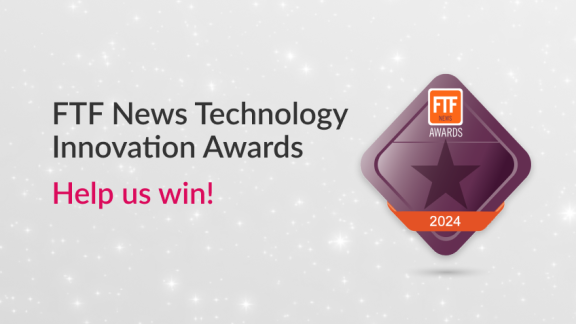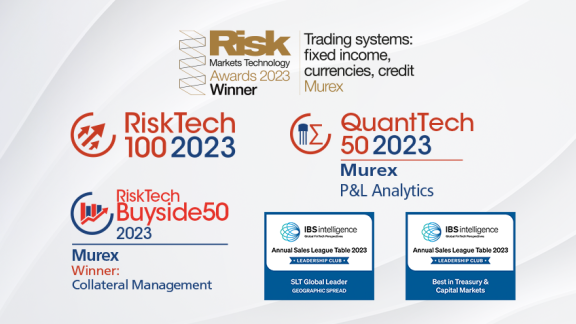-
Our solutions

Vote for us in the following categories:
Vote for us!
20. Best Professional Services Provider
30. Service Provider of the Year
31. Software Solution of the Year- Our clients

With 300 clients and 60,000 users spread across 60 countries around the world, Murex has a truly international client base of capital markets participants.
view all case studies- Insights
- Who we are

Our awards highlight a strong level of customer satisfaction and acknowledge our market expertise.
Visit our awards webpage- Our partners
- Careers
Murex Explores How Digital Assets, DLT Might Reshape Digital Landscape
DLT and digital standards: An emerging reality for capital markets infrastructure evolution?
In a Sibos 2022 session, Murex Digital Assets Product Manager Léandre Moreno examines business cases being implemented across digital assets—including cryptocurrency, CBDC, security tokens and more—and public and private DLT use.
Léandre synthesized his presentation in the blog post that follows.
Breakthrough technologies such as distributed ledger technology (DLT) continue to gain traction—their disruptive potential on market infrastructure evolution is largely accepted today. Almost 90 percent of central banks are running a proof of concept on Central Bank Digital Currency (CBDC), according to an October McKinsey article.
In a Sibos 2022 session, I described how these implementations, along with industry led standardization initiatives, can shape the future digital landscape, enhancing transparency and efficiency.
Background
Bitcoin and Ethereum demonstrated decentralization was possible, technology-wise. Ethereum has been and continues to be a catalyst for digital asset evolution—think utility tokens, smart contracts, non-fungible tokens and decentralized finance.
Since then, the market infrastructure landscape has evolved with, on one side, new public DLT infrastructures completed with enterprise DLT (also known as private DLT). This allows users to leverage technology for use cases where access control and participant permission check is needed.
Additionally, access to the cryptocurrency market has been much improved with the emergence of centralized exchanges. By masking the specifics of this market, like the creation of a hot wallet, centralized exchanges popularized access to end consumers while providing liquidity provider and custody services, among others. Nevertheless, recent events around FTX demonstrate that actors need to gain maturity in order to gain the level of confidence provided by traditional exchanges, to put it mildly. An FTX-like event is intense and dramatic, and it forces the evolution of the digital assets ecosystem toward more regulations. This offers more protection to final consumers.
Since Bitcoin and Ethereum, new forms of assets have emerged, including stablecoin, CBDC, derivatives products implemented via smart contracts, NFTs and more recently, soulbound tokens (SBTs). At Sibos, while highlighting the importance of infrastructure interoperability, I illustrated how those functional building blocks can be assembled to:
1. Digitalize the debt issuance process on the primary market to wholesale investors.
2. Resell securities debt on the secondary market to retail investors.
3. Allow a retail investor to put this security as collateral in order to get cash back.Digital issuance on the primary market for wholesale investors
At Sibos, I presented a scenario introducing a centralized actor playing the role of a traditional exchange offering a space for debt issuers to meet wholesale investors. This centralized exchange acts as a bridge between the off-chain and on-chain ecosystem.
It starts with the onboarding of primary investors and issuers on the top part of the picture with a know-your-customer (KYC) check to control both issuer and investor identities. This centralized exchange enables investors to deposit fiat currency and to swap them against CBDC. This centralized exchange can be built also on DLT infrastructure, connected to existing central bank systems managing the fiat accounts of the bank. (cf. Project Aurum from Bank for International Settlements)
At the bottom right, issuers can mint security tokens that will be the smart contract that the issuer’s debt investors will then acquire by swapping them against digital assets they already have. Based on security tokens, it will enable these debt instruments to autonomously trigger key aspects of the contract, such as coupons payment or repayment of the principal amount, whatever the blockchain at which it is stored.
Positioning this DLT as an authoritative datastore brings several advantages. It provides:
• Speed: Thanks to the atomic swap, there is no more settlement delay and, as a result, no more settlement risk.
• Transparency: Regulators can join the network and look at all transactions in real-time.
• Efficiency: The number of intermediaries is limited when it leads to a life cycle event, such as a corporate action.
• Reconciliation: This is by design.Various proof of concepts have been launched by central banks around the world. Recently, the central banks of France and Luxembourg completed a CBDC experiment by settling a EUR 100 million digital native bond. This exercise has proven benefits the technology can bring by enabling digital assets to be issued, distributed and settled within the Eurozone in a single day.
Reselling on the secondary market to retail investors
Wholesale investors (i.e., the seller) may want to resell—entirely or partially—securities on the secondary market to retail investors (i.e., the buyer). Imagine the seller selects a public DLT to reach a maximum number of potential buyers. After connecting their wallet, the seller simply needs to put an order to sell securities acquired on the primary market. Buyers simply need to swap their bank stablecoin pegged to CBDC, retail CBDC or even cryptocurrencies against security tokens.
This might seem simple in principle. However, the apparent simplicity masks real complexity on the technology side. The same smart contract could be listed on different DLTs (either on the private or on the public one for those that have been resold to retail investors), but whatever the DLT is, this smart contract must behave the same way. Relying on two different infrastructures, this scenario highlights the importance of interoperability between those infrastructures to ensure that the representation of the smart contract and what it contractually delivers works the same way, especially when the smart contract becomes complex through a series of automated life-cycle events. A smart contract must be executed seamlessly in both ecosystems. This is where standardization of process and data like CDM, ISO20022 and smart contract standards (e.g., ERC20) will play a capital role in this ecosystem.
Investor willing to borrow cash putting down securities as collateral
To highlight the importance of infrastructure interoperability, I detailed a case where a buyer on the secondary market (orange) needs to borrow digital assets, putting up acquired securities as collateral (green). We can easily foresee the challenge linked to the interoperability and the absolute need for standardization required for the technology to impact the full value chain more globally.
I addressed the various DLT options and their impact on the digital landscape of tomorrow, emphasizing that technical solutions like DLT must answer a need. Disruption of the process must be understood by all participating actors. A digital standard should be a prerequisite to avoid interoperability issues in the ecosystem.
Change is coming. With industry led standardization initiatives, it might be an exciting time.
For more information, watch Léandre Moreno’s open theater presentation at Sibos 2022:
You might be interested in ...
- Video
Sabine Farhat Discusses Integrated Platform Benefits at ICMA FinTech and Digitalisation Forum
Watch the video- Article
Preparing Clients for LIBOR Discontinuation Scope and Challenges: Part 2 of a Murex Experts Q&A
Read more- Article
Preparing Clients for LIBOR Discontinuation Scope and Challenges: Part 1 of a Murex Experts Q&A
Read more- Video
Murex's Sabine Farhat Highlights Solution to Navigate Changing Securities Finance Landscape
Watch the video - Our clients


